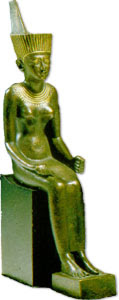 Neith is one of the oldest Egyptian goddesses. Early in Egyptian history she was honored throughout
Neith is one of the oldest Egyptian goddesses. Early in Egyptian history she was honored throughout
She was sometimes depicted as a woman wearing the crown of the north and holding either a sceptre or a bow and two arrows. At other times she was shown as a woman wearing a shuttle (a tool used in weaving) on her head.
It is believed that she was originally a goddess of war (due to the bow and arrows imagery) and may have become later a goddess of weaving (when wearing the shuttle). She was occasionally shown suckling a crocodile who represented her son, Sobek. She was self-produced and the Egyptians believed she was of both a masculine and feminine nature. It was said that Neith gave birth to Re while she was still in the waters of Nun. Neith was the protectoress of Duamutef, the guardian of the deceased's stomach.
During the dispute between Seth and Horus for the throne of
Her largest temple, Sapi-meht, was located at